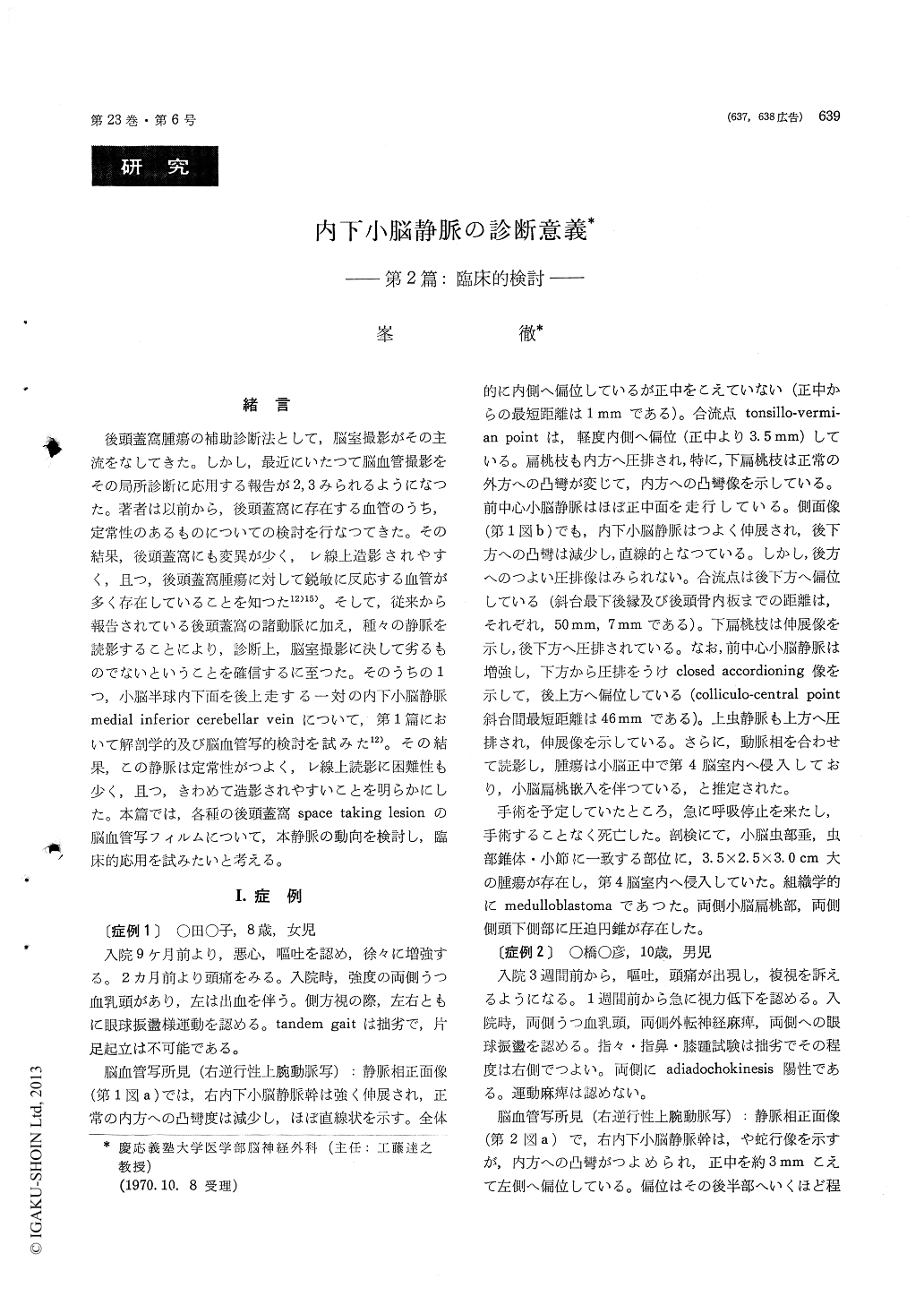Japanese
English
- 有料閲覧
- Abstract 文献概要
- 1ページ目 Look Inside
緒言
後頭蓋窩腫瘍の補助診断法として,脳室撮影がその主流をなしてきた。しかし,最近にいたつて脳血管撮影をその局所診断に応用する報告が2,3みられるようになつた。著者は以前から,後頭蓋窩に存在する血管のうち,定常性のあるものについての検討を行なつてきた。その結果,後頭蓋窩にも変異が少く,レ線上造影されやすく,且つ,後頭蓋窩腫瘍に対して鋭敏に反応する血管が多く存在していることを知つた12)15)。そして,従来から報告されている後頭蓋窩の諸動脈に加え,種々の静脈を読影することにより,診断上,脳室撮影に決して劣るものでないということを確信するに至つた。そのうちの1つ,小脳半球内下面を後上走する一対の内下小脳静脈medial inferior cerebellar veinについて,第1篇において解剖学的及び脳血管写的検討を試みた12)。その結果,この静脈は定常性がつよく,レ線上読影に困難性も少く,且つ,きわめて造影されやすいことを明らかにした。本篇では,各種の後頭蓋窩space taking lesionの脳血管写フィルムについて,本静脈の動向を検討し,臨床的応用を試みたいと考える。
The configuration and the course of the medial inferior cerebellar vein are influenced by the various space taking lesions in the posterior fossa, and this vein suggests the changes of the anatomical struc-ture of the medial inferior aspect of the cerebellum.
1) Lesions in cerebellar hemisphere : In a-p view, the stem of the ipsilateral medial inferior cerebellar vein deviates towards medially and a regular lateral concave curve shows straightening and unrolling. The lateral view is not cotributory for diagnosis except for mild elongation of the vein.
2) Lesions in medial inferior part of the cere-bellum : In a-p view, the stem shows elongation and the regular lateral concave curve shows straight-ening, though no medial displacement is observed generally. In lateral view, the stem shows definite posterior inferior suppression specifically, namely elongation or straightening of the stem is observed. The tonsillo-vermian point also is displaced down-wards.
3) Cerebello-tonsilar herniation : The tonsillo-vermian point is displaced posteriorly and inferiorly together with medial suppression. The superior and the inferior tonsilar branches of this vein are depressed downwards, elongated and medially dis-placed. The inferior tonsilar branch becomes almost straight by medial suppression in a-p view.
In conclusion, the angiographical evaluation of the course of the medial inferior cerebellar wein is significant in diagnosis of the space occupying lesionin the posterior fossa, especially in the posterior inferior part of the cerebellum. In the topographical diagnosis of the posterior fossa space occupying lesions, the medial inferior cerebellar vein together with the precentral cerebellar vein and the posterior inferior cerebellar artery have a significant diagnostic value, and the detailed evaluation of the above angiographical pictures gives an adequate evaluation of the posterior fossa space occupying lesion.

Copyright © 1971, Igaku-Shoin Ltd. All rights reserved.


